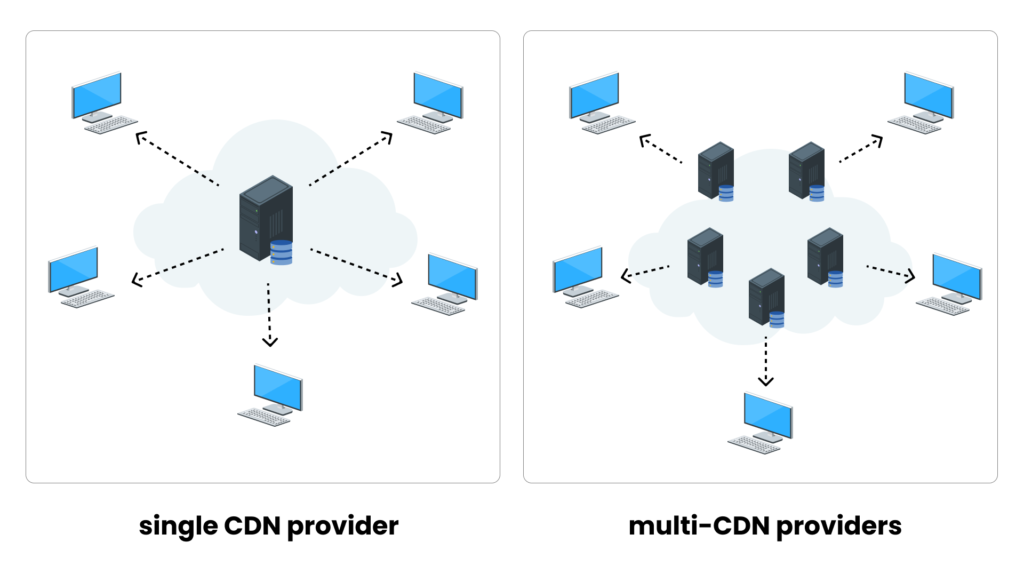Understanding multi-CDN: benefits and best practices
Imagine that your latest piece of content just dropped, your viewers are trying to stream simultaneously, and suddenly your CDN provider experiences an outage. Within minutes, your social media channels are flooded with frustrated users, and your customer support team is overwhelmed. What’s worse, your reputation takes a hit that could last months.
This nightmare scenario has prompted media companies and content creators to adopt a multi-CDN strategy. This guide will show you how to build a multi-CDN solution that transforms your content delivery from a single point of failure into a robust, intelligent system that automatically adapts to deliver peak performance around the clock.
What is a multi-CDN strategy?
A multi-CDN strategy involves using multiple CDN providers instead of relying on a single provider. Think of it as having multiple backup plans for delivering your content to users worldwide.
When someone wants to watch your video or download your content, the system chooses the fastest provider.
With a single CDN, you’re stuck if that provider has problems. Your content goes down, and your users can’t access it. That’s risky. Multi-CDN infrastructure gives you backup options. If one CDN provider has outages or runs slowly, your content automatically switches to another provider. Your users never notice the difference, but you get much better reliability.

How does multi-CDN work?
Behind the scenes, multi-CDN systems work like smart traffic controllers for the Internet. Instead of sending all your content through one route, they constantly monitor which CDN providers are performing best and automatically route traffic to the fastest option available.
Think of it like having multiple highways to get to the same destination. A smart GPS system would check traffic conditions in real-time and direct you down whichever route gets you there the fastest. That’s essentially what multi-CDN infrastructure does for your content.
When a user requests content, the system has several ways to decide which CDN provider should handle it:
- DNS load balancing can use simple round-robin (taking turns between providers), weighted distribution (sending more traffic to better CDN providers), or location-based routing (picking the closest provider to the user). For example, if someone in Tokyo requests a video, the system directs them to a provider with strong coverage in Asia. A user in New York gets duplicate content from a different provider optimised for North America. Both get optimal performance using other networks.
- Performance data-driven load balancing takes it a step further by making decisions based on real-time information. The system continuously monitors the response times of each CDN provider, checking for outages or slowdowns, and then automatically selects the best-performing CDN at that moment.
- Primary/backup configurations use a primary CDN with backup providers, while others employ CDN aggregator platforms that manage multiple CDNs through a single control panel.
- Automatic failover capabilities ensure traffic immediately switches to backups if one CDN provider has problems. This happens so quickly that users rarely notice interruptions.
Pros and cons of a multi-CDN strategy

Pros
Improved reliability and backup coverage
The most significant advantage of multi-CDN is that when CDN provider outages happen, your content stays online because multiple CDNs automatically take over. Think of it like having various power sources for your home. If one fails, the others keep the lights on. A multi-CDN infrastructure provides the same reliability for your content, ensuring consistent and reliable content delivery even during unexpected issues.
Enhanced performance and speed
Multiple CDN providers excel in different regions and content types. Some are lightning-fast in Asia, others dominate Europe, and some specialise in video streaming, while others handle websites better. The result is reduced latency, faster loading times, and a better user experience globally.
Cost optimisation and vendor flexibility
A multi-CDN strategy often results in cost savings through intelligent traffic distribution. You can route expensive, high-priority content like live video streams through premium providers while using more affordable options for basic files like images and documents. This optimisation based on performance data helps control costs without sacrificing quality.
You also gain negotiating power with multiple vendors. Instead of being locked into one contract, you can leverage competition between providers to get better pricing and terms. If one CDN provider raises prices or reduces service quality, you can easily shift more traffic to alternatives without disrupting your service.
Global coverage and scalability
Using multiple CDNs dramatically expands your reach. You get the combined global footprint of all your providers, rather than being limited to one CDN provider’s network. This approach also handles traffic spikes much better. When demand surges, load balancing across multiple providers prevents any single network from becoming overwhelmed. Your content delivery scales automatically as traffic grows, without requiring manual intervention or emergency upgrades.
Additional security and features
Different CDN providers offer unique capabilities – some excel at DDoS protection, others provide advanced edge computing features, and some specialise in video optimisation. Multi-CDN combines these various strengths, giving you access to the best tools from each provider rather than settling for a single vendor’s comprehensive package. This diversity also improves security since distributing content across multiple providers reduces the impact of any single security breach or attack.
Cons
Increased complexity and setup costs
Managing multiple CDN providers is significantly more complex than working with a single CDN provider. You need specialised expertise to configure and monitor each provider, plus separate contracts with multiple vendors. While multi-CDN can lead to cost savings through optimised traffic distribution and better negotiating power, the initial setup and administrative costs are higher.
Integration challenges
Getting multiple CDN providers to work together requires significant development effort. Each provider has different APIs and systems, making consistent content delivery across all providers technically challenging.
Performance variability
Using multiple providers can sometimes create inconsistent user experiences, as different CDN providers may perform differently under various conditions.
Not for everyone
Multi-CDN infrastructure typically makes sense only for organisations with substantial global traffic and technical resources. Smaller companies may find a well-chosen single CDN provider more practical than managing the complexity of multiple CDN providers.
Best practices for multi-CDN implementation
Strategic provider selection and testing
Don’t rush into multi-CDN implementation – carefully evaluate different CDN providers based on geographic coverage, network performance, pricing models, and feature sets. Narrow your choices down to two providers and run proof-of-concept tests and A/B testing over several weeks to determine which of the multiple providers best meet your requirements.
Ensure that all your chosen CDN providers offer similar essential features, such as security protection, encrypted connections, content caching rules, and management interfaces. Your multi-CDN approach only works if all providers can deliver the same level of service and functionality that your users expect.
Gradual traffic transition and configuration
Configure your new CDN provider by meticulously replicating settings from your primary single CDN setup. Each policy and behaviour needs careful configuration using the provider’s API, followed by rigorous testing to ensure optimal performance.
Initiate multi-CDN implementation with an active-active strategy, where multiple providers operate simultaneously. Begin by directing only 5-10% of traffic to the new provider while your leading provider handles 90-95%. Gradually increase the new provider’s share based on performance results and your comfort level, while closely monitoring network performance at each stage. This progressive approach enables you to test with real users without significant risk.
Advanced traffic management and monitoring
Implement specialised traffic management tools that automate routing decisions based on real-time conditions. Avoid basic DNS switching services that lack visibility; instead, use solutions that provide comprehensive traffic insights and dynamic load balancing across multiple CDN providers.
Keep all CDN providers active, allocating a portion of the traffic to maintain warm caches. Never completely starve any provider, as this reduces the effectiveness of your multi-CDN architecture.
Content optimisation and performance monitoring
Group content by type to ensure each CDN provider handles what they do best. Route static content, such as images, through one provider while directing video streams through another that specialises in media delivery.
Establish consistent monitoring parameters across all providers to track network performance, latency, and availability. Use unified dashboards that integrate all CDN providers for comprehensive visibility into your content delivery infrastructure.
Automated failover and redundancy
Implement automated health checks that continuously monitor the availability and performance of each CDN provider. Set up automatic traffic redirection in the event of CDN provider outages, ensuring uninterrupted content delivery without manual intervention.
Design backup strategies that automatically reroute traffic during performance issues, minimising service disruptions and maintaining consistent user requests content fulfilment across your multi-CDN approach.
Ready to build your multi-CDN strategy?
Implementing a successful multi-CDN strategy requires careful planning, technical expertise, and ongoing optimisation. At Spyrosoft BSG, we’ve helped media companies transform their content delivery infrastructure through proven multi-CDN implementations.
Whether you’re looking to improve reliability, expand global reach, or optimise costs, our team can guide you through every aspect of multi-CDN setup and implementation.
Check our offer to learn how we can help you transform your content delivery strategy.
About the author
Contact us




![[thumbnail] media and entertainment - android tv guide](https://spyro-soft.com/wp-content/uploads/2025/06/thumbnail-media-and-entertainment-android-tv-guide-1024x655.png)
